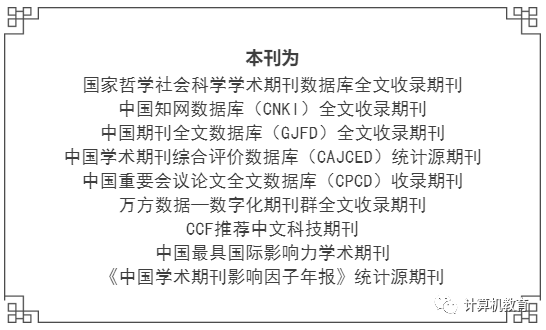0 Introduction
At the National Science and Technology Awards Conference in 2017, Premier Li Keqiang pointed out that we must comprehensively improve our technological innovation capability and strengthen the foundation of the country’s core competitiveness. At the 2018 National Higher Education Work Conference, Minister of Education Chen Baosheng emphasized the importance of writing a “pen of progress” and that innovative development is more urgent. Talent cultivation is the foundation of technological innovation, and the fundamental task of higher education is talent cultivation. Continuously improving the quality of talent cultivation is the eternal pursuit of higher education institutions[1]. Undergraduate education has undergone a series of reforms, such as adhering to a “student-centered” approach and actively exploring new models for cultivating innovative talent; reforming teaching methods and improving management mechanisms[2-3]. These measures have achieved significant results. However, in the exploration and practice of cultivating innovative talent, the issues of insufficient practical ability and lack of comprehensive innovative capability among undergraduate computer students in local colleges remain prominent[4-5]. In light of this, the author focuses on the newly established innovation capability training course for computer majors at Xi’an University of Technology to address the following issues.
1) The systematic weakness and insufficient structure of practical teaching restrict students’ comprehensive practical ability.
This is specifically manifested in outdated practical teaching content, mechanical teaching methods, dull experimental processes, and monotonous experimental phenomena, leading to low student interest and weak initiative in the experimental phase; a large proportion of practical teaching involves verifying theoretical content[6-7], while the proportion of comprehensive and design-oriented experiments that cultivate students’ application abilities is relatively low, resulting in a serious lack of innovation capability cultivation and ineffective enhancement of students’ practical abilities. The practical phase fails to consolidate and deepen theoretical knowledge. Single-course experiments are prone to fall into information silos, making it difficult to effectively achieve a progressive connection between experiments and applications.
2) The mechanism for cultivating innovative awareness and capabilities is not well established, making it difficult to meet the needs of an innovative society for talent.
Specifically, although students form a knowledge system and possess certain practical abilities through several courses’ theoretical and practical teaching, they lack experience in high-level research projects and innovation and entrepreneurship projects, and their innovative awareness has yet to form. Additionally, there is a lack of management mechanisms that encourage innovation, resulting in a lack of innovative literacy and insufficient innovative capabilities among students.
The above issues urgently need to be addressed in the cultivation of innovative talents in the new era of computing. To better cultivate innovative talents, it is imperative to conduct in-depth research on the cultivation model of innovative talents in local colleges and explore new solutions.
1 Feasibility Analysis of the Experimental Model in the Computer Innovation Capability Training Course
The computer innovation capability training is a practical course. Following the principles of “interest-driven, classroom internalization, and practice reinforcement,” it encourages students to engage in innovative training and practice, implement teamwork, and participate in innovation competitions; students are encouraged to actively participate in various high-level subject competitions, allowing them to improve their innovative spirit, awareness, and entrepreneurship abilities through practice.
The course model includes expert reports from both inside and outside the university and competition-based innovative experimental design. The report content may include reports on basic knowledge of innovation, themes of innovation competitions, CCF (China Computer Federation) reports entering universities, and reports on entrepreneurial experiences; the innovative experiments are adapted from award-winning works from previous competitions, aiming to help students initially understand the basic knowledge required for competitions, thereby promoting students’ mastery of innovative concepts, innovative thinking, and innovative techniques, understanding the content and basic rules of major domestic competitions, mastering the analysis methods, ideas, and skills needed to participate in innovation competitions, as well as understanding the concepts of entrepreneurship and the relationship between innovation and entrepreneurship, and the composition of entrepreneurial teams, cultivating a correct view of entrepreneurship.
1) Taking expert reports and innovative experiments as opportunities, combined with the innovative credit system, to enhance students’ enthusiasm for innovative design.
The expert reports are primarily composed of senior industry experts, competition winners, and young entrepreneurs, focusing on how to enable students to flexibly apply their knowledge and how to effectively choose their interest directions for innovation, thus stimulating students’ subjective initiative, constructing new ideas in conjunction with technological development, and forming new thoughts.
Innovative experiments differ from conventional fixed experiments; they are derived from competition projects, and the experiments possess novelty and extensibility, with a new set added each year and timely updates to topics, helping students encounter novel topics, broaden their thinking, and enhance their ability to apply existing knowledge to unknown fields.
Innovative credits are compulsory for undergraduate students. Based on this, the computer major aligns with the creative requirements in graduation criteria, guiding students to actively participate in research activities. The credits cover competitions, papers, patents, and small inventions and creations, eliminating previous recognition operations such as reading reflections and driving licenses, thereby promoting students’ active participation in various technological activities to some extent. The innovation capability training course serves as an intermediate node in learning, effectively bridging students’ understanding of research or competitions, enabling them to comprehensively recognize the theoretical significance and practical value of innovation.
The teaching model of the computer innovation capability training course is shown in Figure 1, where the entire teaching process consists of interest stimulation, classroom internalization, and practice reinforcement.
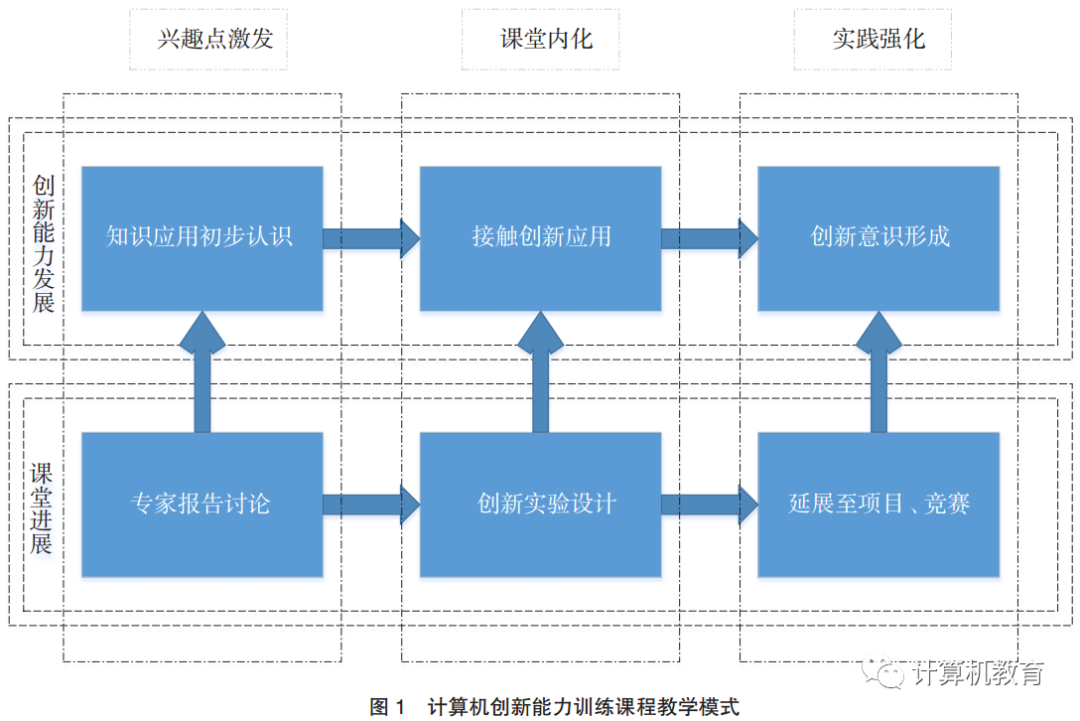
Taking the intelligent vehicle data collection innovative experiment as an example, during the innovative experiment process, students not only complete the necessary fixed-point collection and obstacle avoidance functions but can also expand to achieve multi-directional, multi-height, and multi-type data collection and analysis. Furthermore, they can replace the basic system and further develop applications, with teachers selecting outstanding projects for the next phase of project cultivation.
2) Promote the formation of a technological innovation capability cultivation system by cultivating awareness, establishing an innovative experimental platform, forming mechanisms, and leading projects to enhance students’ comprehensive innovative capabilities.
Through the cultivation provided by the computer innovation capability training course, establish an innovative discussion process, train students’ hands-on innovation ability through innovative experiments, provide a publicity platform for student technological organizations such as software study groups and ACM competition clubs, create an environment for discussion, debate, and questioning, stimulate students’ thinking activity, and cultivate their innovative spirit and innovative abilities.
In recent years, supported by student research and competition groups at the school, students have had numerous opportunities to engage with university student innovation and entrepreneurship training projects and various major competitions. Such innovative experiments are highly feasible for students, who are curious about competitions and wish to personally practice award-winning projects to understand the basic requirements of competitions. The computer college provides sufficient competition report experts and entrepreneurial talents through organizations such as the software study group and ACM competition club. Adequate personnel means that through the initial application of the innovative experimental model, using extensible innovative experimental design as an opportunity, a platform and its mechanisms can be formed. Through student-led projects, the training of innovative capabilities can be achieved.
2 Innovative Experimental Model – Taking Intelligent Vehicle Data Collection Experiment Design as an Example
The experiment is sourced from university student innovation and entrepreneurship training projects and award-winning works from student competitions. It should, in principle, have a specific design scheme, reproducible experimental drawings, and clear experimental objectives. The experimental process follows the flow of “preparation of works – simplification and improvement – hardware wiring construction drawings – software implementation – extension of functions”. Using intelligent vehicle data collection experiment design as an example, the practical process of the experimental model is specifically described. The preliminary goal of this experiment is for students to successfully assemble the vehicle and achieve the straight travel, turning, and obstacle avoidance functions, and to expand to achieve onboard sensor data collection.
2.1 Overall Experimental Design
The experiment originates from the 2017 student-led university student innovation and entrepreneurship training project – design and implementation of data signal collection devices and methods in complex environments. This project won the second prize at the university level in the 2018 “Internet+” University Student Innovation and Entrepreneurship Competition. After design modifications, it has become easy to understand and convenient for classroom operation.
The experiment consists of two parts: hardware and software. It is based on the Arduino development platform for intelligent vehicles, with hardware components including an Arduino circuit board for circuit connections, equipped with a Raspberry Pi, temperature sensors, ultrasonic sensors, humidity sensors, road strips, servos, gyroscopes, etc. The Arduino is powered via a USB interface and uses an external 9VDC input. The software part is built on the open-source simple I/O interface version, with an integrated development environment similar to Java C language development environments like Arduino IDE, which is user-friendly, with simple syntax, convenient for downloading programs, and allows direct editing of the program that implements vehicle functions in the Arduino IDE, which is then uploaded to the Arduino circuit board for corresponding control to achieve the design functions. The schematic diagram of the hardware setup in the innovative experiment is shown in Figure 2.
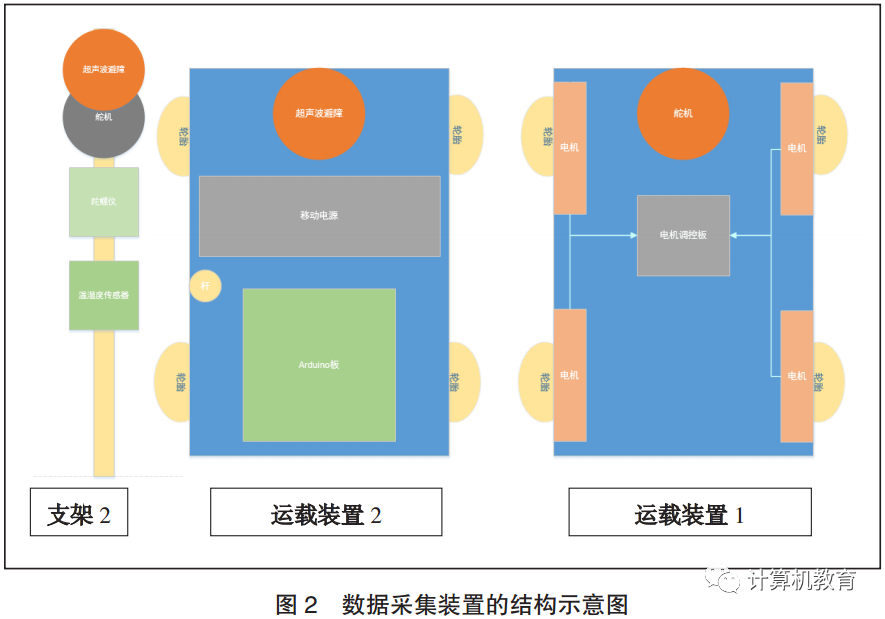
The innovative experiment designed by the author – intelligent vehicle data collection device includes the intelligent vehicle and the data collection device. The data collection device is based on the carrying device, with a bracket installed on the upper part of the carrying device, where the collection equipment is installed, connecting the collection equipment with the carrying device and terminal equipment. The carrying device includes an Arduino main control board, which connects to the XBEE module, DC power supply, distance sensor, motor driver module, servo, and LED indicator light. The motor driver module is connected to the DC motor, which drives the wheels of the intelligent vehicle, and the XBEE module connects to the collection equipment.
2.2 Basic Function – Obstacle Avoidance and Movement of the Intelligent Vehicle
In the testing environment, road strips are installed to facilitate the intelligent vehicle’s movement along the path. When the intelligent vehicle encounters obstacles during its movement, the sensors must detect the obstacles while controlling the vehicle to avoid fixed obstacles, achieving the obstacle avoidance function. The ultrasonic distance measuring method is used to detect obstacles ahead; when the distance between the vehicle and the obstacles is less than the predetermined warning value, the vehicle adjusts its direction of travel based on the detected conditions of the left and right sides of the road using the servo, while recording the direction change for returning to the designated route after passing the obstacle. Additionally, based on the previously traveled road records and the designated route, the vehicle controls its movement and stops at the detection point, then runs the data collection device. If the detection point has clear markers such as yellow dots, the vehicle can assist in detecting whether it has reached the detection point using infrared devices to improve accuracy.
2.3 Extended Function – Installation and Communication of the Collection Device
The data collection device is installed on the vehicle’s carrying platform. When reaching the data collection point, the intelligent vehicle runs the equipment through Arduino control, the sensors collect data, and the WiFi module transmits the data, while the SD card stores the data.
The intelligent vehicle travels along the collection road strip, stopping at each designated collection point to trigger the sensors for data collection. The vehicle must perform obstacle avoidance operations while traveling along the road strip. Here, the ultrasonic distance measuring method is used to detect obstacles; complete relevant simple code. When the distance between the collection device and obstacles is less than the predetermined warning value, the vehicle adjusts its direction of travel based on the road conditions on both sides of the collection device while recording the adjusted direction for returning to the designated collection road strip after passing the obstacle.
Based on the designated collection points and road strips, the intelligent vehicle’s speed and running time are set to control the intelligent vehicle to travel along the collection road strip. During data collection, based on the designated collection points, the vehicle is controlled to stop upon reaching the collection points, completing RSSI signal collection in four directions before continuing to the next collection point.
3 Application Practice
The computer innovation training course at Xi’an University of Technology is offered to second-year students majoring in Computer Science and Technology and first-year students in the Excellence Class during the spring semester. So far, a total of 179 students have practiced the intelligent vehicle data collection innovative experiment over two sessions, as shown in Figure 3.
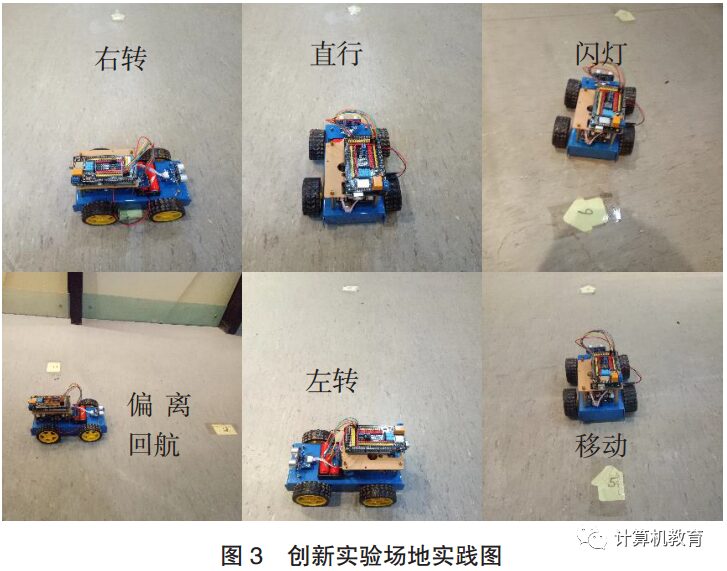
A satisfaction survey was conducted using a questionnaire, with a total participation of 153 people, accounting for 85.5% of the total number. The survey results are shown in Table 1.
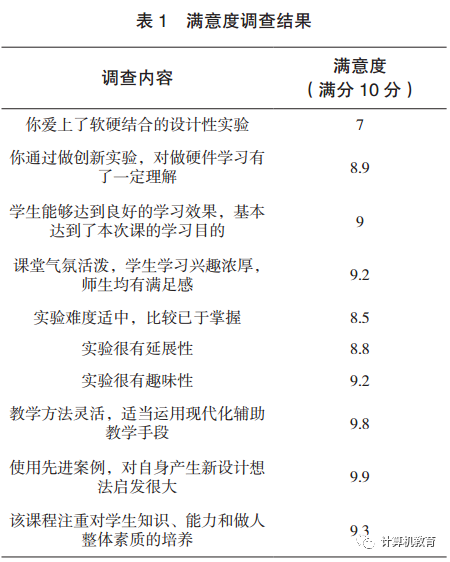
The survey statistics indicate that for various satisfaction indicators regarding the computer innovation capability training course and the intelligent vehicle data collection innovative experiment, 90% scored above 8.5 points (out of 10), meeting the satisfaction standard.
4 Conclusion
In response to the lack of practical operations for innovation capabilities in traditional talent cultivation processes, the author has designed an innovative experimental model combined with the computer innovation training course based on the principles of “interest-driven, classroom internalization, and practice reinforcement.” Using the intelligent vehicle data collection experiment as an example, the process follows “preparation of works – simplification and improvement – hardware wiring construction drawings – software implementation – extension of functions,” progressively achieving more challenging innovative experimental operations than conventional experiments, thus expanding students’ thinking. First, by taking competition works as an opportunity, the design ideas are transferred into practical applications, enhancing the freshness of the experiments and their potential for keeping pace with the times; second, the experimental content closely revolves around the latest research directions in the country, broadening students’ horizons, increasing their interest in computer research and development, and driving their proactive learning and exploration of related knowledge; third, the experimental content involves a large amount of on-site implementation, differing from fixed experimental thinking, enhancing practical abilities and teamwork skills. From the practical results, the innovative experimental design is novel and interesting, achieving good teaching effects. In the future, the innovative experimental content will be updated in real-time in conjunction with the development of computer professional technology to promote students’ better mastery and learning of artificial intelligence application technologies.
References
[1] Li Zuchao, Zhang Li. Exploration of Pathways for Cultivating Innovation Capabilities of Graduate Students in Science and Engineering: An Analysis Based on Structural Equation Modeling [J]. Higher Education Research, 2014(11): 60-67.
[2] Zhang Jianxiang. The Connotation and Essential Characteristics of Performance Evaluation of Talent Cultivation in Higher Education Institutions [J]. Educational Research, 2018(3): 55-61.
[3] Yu Haiqin. The Innovation Behavior Model of College Students and Its Value: Based on Grounded Theory Research on Undergraduate Top Innovative Talents [J]. Higher Education Research, 2019(9): 68-77.
[4] Li Wei, Shen Xiaoling, Wang Lei, et al. Exploration and Practice of Agile Teaching [J]. Computer Education, 2019(9): 129-133.
[5] Liu Xianjun. Exploration of Personalized Education Models [J]. Higher Education Research, 2020(1): 1-8.
[6] Li Qing’an, Yuan Mengting, Wang Hanfei, et al. Design of Compilation Experiment Courses Based on LLVM [J]. Computer Education, 2019(2): 11-14
[7] Gong Xiaolin. Opportunities, Challenges, and Responses for the Development of Newly Established Local Undergraduate Colleges under the Background of “Double First Class” [J]. Teaching Research, 2019(11): 27-33.
Fund Project: Xi’an University of Technology Graduate Teaching Reform Project (252041913); Xi’an University of Technology Teaching Research Project (xjy2054, 310-252041906).
First Author’s Introduction: Fei Rong, female, Associate Professor at Xi’an University of Technology, research direction is adaptive dynamic programming and deep learning theory, [email protected].
Citation Format: Fei Rong, Huang Tao, Xu Qingzheng, et al. Exploration of Teaching Reform in Computer Innovation Capability Training Course[J]. Computer Education, 2021(6): 92-94,99.
(WeChat Editor: Shi Zhiwei)
More Exciting:
Professor Chen Daoxu from Nanjing University: Which is more important, teaching students to ask questions or teaching students to answer questions?
Professor Xu Xiaofei from Harbin Institute of Technology: Exploration and Reflection on the Construction of New Engineering Education and Educational Model Innovation Practice in Our Universities
[Editor’s Note] The Enlightenment Brought by “Online Teaching is Possible”
Table of Contents of “Computer Education” 2021 Issue 6
5118 Courses! The Ministry of Education Officially Announces the First Batch of National First-Class Undergraduate Courses
The Ministry of Education Details the Announcement of the First Batch of National First-Class Undergraduate Courses
[Yan Ten Series]: Development Trends of Computer Disciplines and Their Impact on Computer Education
Professor Li Xiaoming from Peking University: From Interesting Mathematics to Interesting Algorithms to Interesting Programming – A Path for Non-Majors to Experience Computational Thinking?
Table of Contents of “Computer Education” 2021 Issue 5
Several Thoughts on Issues Related to Building a First-Class Computer Discipline
Professor Liu Yunhao from Tsinghua University Answers 2,000 AI Questions
Table of Contents of “Computer Education” 2021 Issue 4
Table of Contents of “Computer Education” 2021 Issue 3
Table of Contents of “Computer Education” 2021 Issue 2
Table of Contents of “Computer Education” 2021 Issue 1
Professor Zhan Dechen from Harbin Institute of Technology: A New Model to Ensure Teaching Quality in Higher Education – Synchronous and Asynchronous Blended Teaching
[Principal Interview] Accelerating the Advancement of Computer Science Education and Becoming a Pathfinder for Data Science Education – An Interview with Professor Zhou Aoying, Vice President of East China Normal University
[Yan Ten Series] Analysis and Suggestions on Quality Issues of Undergraduate Computer Courses
Analysis and Enlightenment of Computer Undergraduate Curriculum Setting at the University of Tokyo, Japan
Teaching Reform and Practice of Artificial Intelligence Courses at Peking University
New Engineering and Big Data Professional Construction
Learning from Others to Improve Ourselves – A Compilation of Research Articles on Computer Education at Home and Abroad
